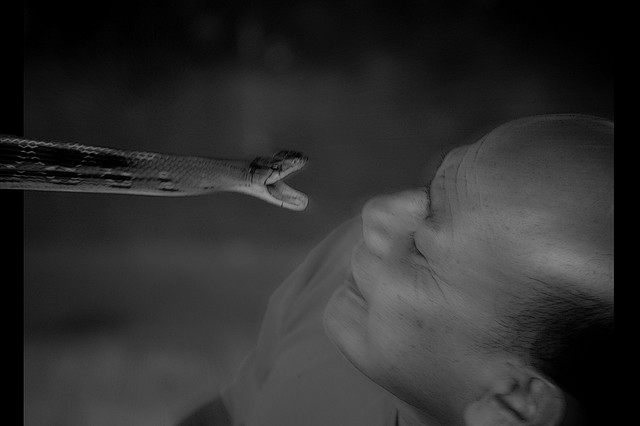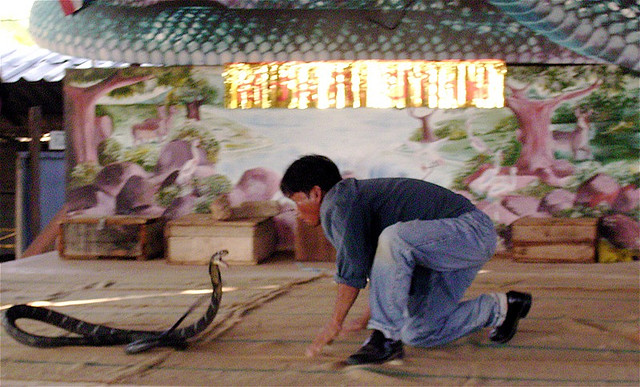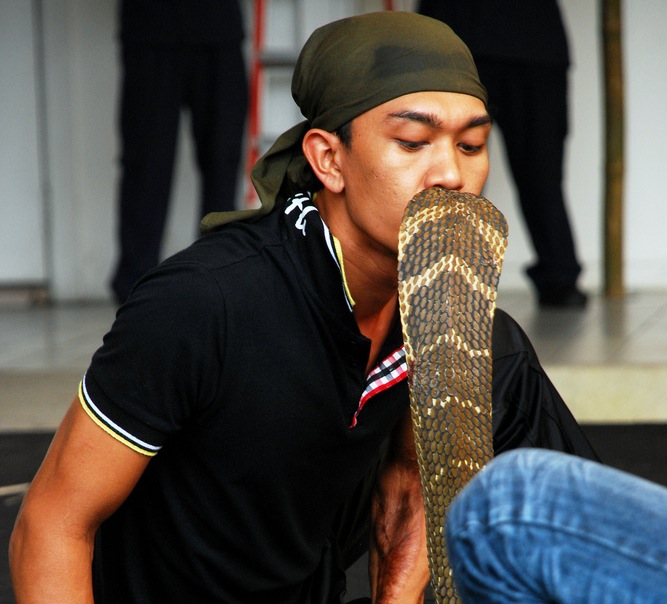Try My Snake Technique: Thailand’s Cobra Farms, First-hand
One of the most enjoyable parts of curating this blog is having the opportunity to work with an amazingly intelligent staff of interns whose personal experiences are as varied as the world itself. Madi’s longread piece below, chronicling her experiences at a snake farm in Thailand, delves into the extremely complicated position tourist are often put in: where do the boundaries of cultural relativism lie (if anywhere), and how ethical is human- or animal-based entertainment to begin with?
Happy reading and ruminating to you, Obscuraphiles, and happiest of travels to Madi as she sets off on a semester-long adventure in India! -Sarah
***
Before the show begins, the presenter, standing on a stool five feet high above the ground, reminds the audience, “This is dangerous game…” he laughs, picking up a picture of a small dark man from his drawer then continuing; “this man, he die during the show.” The audience sighs, and then the show begins.
Among the risky and blood-curdling performances that make an audience of star-stricken tourists give a loud “Whoa whoa whoa!” (three times being just about right) are the snake fighters.

(source)
Standing in a small arena facing two king cobras, the snake fighter begins by concentrating on the mass of curling poison, clenching his fists and bending his knees to find balance. Then, while focusing all his attention on the snakes’ movements, he suddenly reaches for one of the cobras’ head, grabbing him firmly before violently throwing him back down to the ground.
Members of the audience clap their hands, praising the snake fighter for his courage.
Then it starts again. This time, the snake fighter raises his arms to the sky, confusing the cobras, who resolve to hiding their head as a defense. But then, surprising his opponent, one of the cobras decides to begin pouncing its head towards his opponent, keen on showing him who’s boss in this animal kingdom. He leaps and dives, spreading his neck in a menacing display of his hood.
After a series of snake-boxing bouts, the snake fighter wins. Had he not been able to overpower the cobra by striking it at that precise moment, the release of the cobra’s venom into his bloodstream could have killed him. Its powerful neurotoxins could pray on animals’ nerves, paralyzing muscles which usually leads to respiratory failure or cardiac arrest. For context: the king cobra’s bite is venemous enough to kill an elephant.

(source)
Then came the carnivorous Mongoose, a crossroad of cat-meets-squirrel-meets-hungry-bird-of-prey, which fights the snake like a demon, seizing the limbless creature with his sharp nails and ripping rosy flesh out with its bear teeth. In such demonstrations, to avoid being killed the snake is taken out before the Mongoose has finished his ravaging. In the past, these gory fight shows almost always led to the snake’s death, but today it is illegal to let the Mongoose kill the snake.
SIDENOTE: In India and Afghanistan (and many other countries I’m sure), a similar creature versus creature battle is staged, this one involving hens with Tabasco up their bums (to intensify energy levels), and enjoyed like an American Idol affair.
The mongoose versus cobra showdown I witnessed looked something like the video below, except it almost seemed like the mongoose was asking for a toothpick after the cobra had been withdrawn, and there was a little more blood and flesh involved:
A couple more shows of man versus snake followed, including one of a snake fighter catching a snake with his mouth (his hands busy, having caught a different poisonous snake with each), and then the show ends with three pirate-looking gents with red ninja-bands around their heads, walking in between the spectators with a cobra’s jaw wide open, pressing a plastic cup onto the snake’s fangs; extracting venom to show the crowd.

(source)
This farm was keen on the cobras, probably because of Thailand’s international fame with the species, but also because they have peculiar characteristics – like two penises – to exhibit to the public.
Before the show, visitors are allowed to walk through a “snake zoo” while waiting for the next show to start. I’d expected to feel absolutely no sympathy for the snakes, especially after one of the first enclosures contained a huge bully of a snake one foot away from a tiny white mouse that had probably been placed in there for feeding purposes. But what I saw next shocked me and made me rethink my judgment.
In a small glass compartment, I noticed a stretch of snake skin slowly disappearing into what appeared to be an opening of some sort. As I stared at this curiosity a little longer, I realized that one snake was swallowing another. The king cobra was eating another snake, unhurriedly swallowing it like a child sluggishly disposing of his plate of vegetables!
So there I had it: a natural barbarity that existed outside the realm of human intervention. A logical implication of “snake is hungry,” and so it eats. Similarly, these villagers make a living out of these snake farms; the presenter, the snake fighters, the receptionists, store clerks, etc- all the people involved in creating this “exotic” experience for us tourists, “feeding” off the brutal defiance involved.

(source)
Although “snake boxing” has existed for hundreds of years in the region, I can’t help but feel that there’s something wrong with its repackaging for touristic purposes. These men must risk their lives, and animals (even snakes!) have to be involuntarily placed in boxing rings to be weakened and pushed to fight for their lives, in order to entertain a “fearless” group of tourists. Sitting there watching these acts, I felt like a coward.
Naturally, it got me to wondering: what (if any) boundaries should we place for ourselves while travelling? Or should we experience the eccentricities of every culture to their highest peaks?
.jpg)
(source)
A piece of writing inscribed on the wall behind the snake show answered my question for me. The wall read, “The anti-venom made to treat the snake fighters is made by injecting horses with enough venom to build immunity. Then, the horse’s blood is used to fight the toxin.” Kant, an eighteenth-century German philosopher, presented a moral maxim that said something like this: “Never ever treat a person as a means, but rather, always treat each and every individual as his/her own end.”
This idea, when applied to our travels, makes it clear that though we are all curious – eager to experience the world in different ways and bending its geographical boundaries, simultaneously challenging our own mental boundaries – there’s no escaping such (as few as they may be) frontiers. Kant’s aphorism seems like a good place to start in defining just where these boundaries lay.



Follow us on Twitter to get the latest on the world's hidden wonders.
Like us on Facebook to get the latest on the world's hidden wonders.
Follow us on Twitter Like us on Facebook